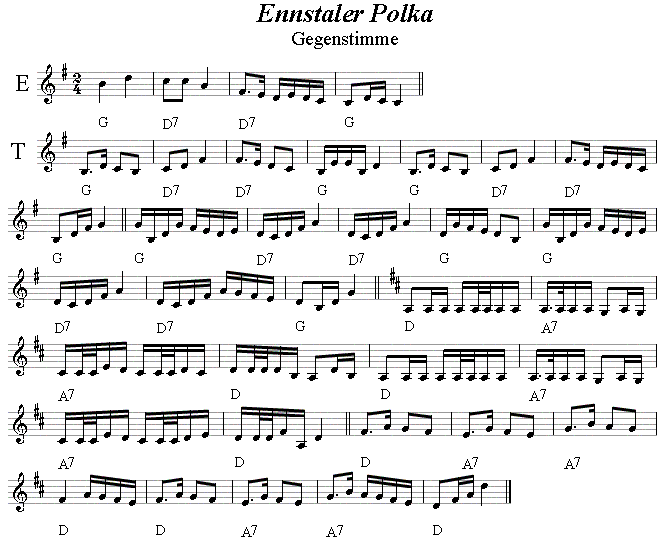|
|
In combination with many melodies a counter melody is suitable. A second melody that is not really in connection to the main melody, this voice is more free, but it should reinforce the main voice and not pull the main voice down. This voice is in most cases below the main voice in a lower position. It often fills the pauses in the melody or carries the rhythm during the long notes common in waltz melodies. This voice often uses arpeggios ( Dreiklangszerlegungen) or fill-ins (Übergänge) with notes of the scale between notes of the main melody. The counter melody is less important and should only be played if 1st and 2nd voices are in use already or in some cases as a later native voice instead of the 3rd voice. Often this counter melody is first implemented when the tune is repeated the second time. First the main voice plays on its own, and later a second counter melody is added as decoration.
Such a counter melody should not be a melody on its own. It should only be used in combination with the main melody, so it has in most cases a very uncomplicated melody.
An easy way to arrange a counter melody is the imitating of the first melody as echo or canon. If the 1st voice is kept on one note, the counter melody repeats the melody phrase and sometime even the following phrase of the main melody is imagined before the main phrase, in some cases adapted a bit toward the new harmonic situation. You can see how this works in the example: Hoehü-Jodler. There you see, the whole melody is moved a half measure and a bit adapted in the last measure.
I play such counter melodies with the Hackbrett (hammered dulcimer) in combination with the Steirischen or with the Steirische in combination with two violins. But you can use all kinds of instruments that can produce melodies. Different Instruments do have different technical performance possibilities. For instance on the Styrian hackbrett I like to use the hammers in a way such that they jump repeatedly, so that fast 16th or 32nd notes are produced. See the example in measures 4 und 5.
In combination with the example, Ennstaler Polka, I show here how one can play such counter melodies. This melody is very well suited to showing this, because the melody is very simple. You can therefore be very creative, you can improvise and play around with anything that comes into your mind, but keep in mind that the counter melody is less important, and should not overwhelm the main voice. Click on the note sheet to hear the counter melody (with bass).
You can see on the following page how it all looks when combined with the main melody.
JavaScript is not functioning on your Pc? Click here to start the midi files.
![]()

